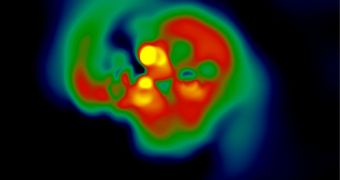New data would appear to indicate that the earliest stars ever to appear in the Universe were in fact spinning at tremendously high speeds. Astronomers now call these objects “spinstars,” and say that they at times reached spinning velocities of about a million miles per hour.
What is so interesting about these objects is that they span so fast regardless of the fact that they were very large. Experts estimate that all of them were massive stars, at least 8 times the mass of our Sun, but probably a lot heavier.
These objects usually go on to live for only a few million years, due to the fact that they exhaust their hydrogen supplies very fast. After they reach the end of their burning cycle, they go on to explode in powerful supernova blasts, which results in the formation of a neutron star or a black hole.
The new study indicates that it took at most 30 million years for these earliest stars to blow up. But the main effect of these supernova blasts was seeing the entire Cosmos with heavy chemical elements.
What this means is that other substances appeared besides hydrogen and helium, which even now make up the bulk of all matter in the Universe. This happened a couple hundred million years after the Big Bang, the event that sprung the Cosmos into existence some 13.75 billion years ago.
The existence of spinstars was inferred from analysis of the globular cluster NGC 6522, and ancient stellar formation that is thought to have come together more than 12 billion years ago. The cluster is believed to be the oldest in the Milky Way, Space reports.
This old age implies that the stars were there when the Universe first got seeded with heavy elements. Yet, chemical analysis of their light revealed the existence of strontium and yttrium, which are very rare and heavy elements.
The only way to explain this apparent discrepancy is if the stars were spinning very fast, explains Cristina Chiappini, who holds an appointment as an astrophysicist at the Leibniz Institute for Astrophysics in Potsdam, Germany.
She and her team conducted the investigation using the Very Large Telescope (VLT), which the European Southern Observatory (ESO) operates at La Silla, in Chile. Data suggest the stars were spinning at speeds of 1.1 million miles per hour (1.8 million kilometers per hour) when they first appeared.
Generally, stars in the Milky Way only spin at around 220,000 miles per hour (360,000 kph), so the difference is staggering. What experts with the research group believe is that the heavy chemicals in these stars were mixed in the stellar nurseries from which they spawned.
This happened after the original spinstars lived and blew up as supernova, disseminating the heavy chemicals they produced all over the place. Details of the new work appear in the April 28 issue of the top scientific journal Nature.

 14 DAY TRIAL //
14 DAY TRIAL //